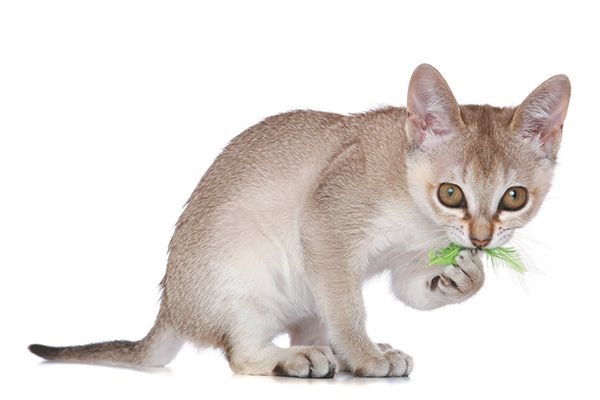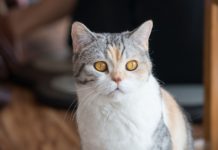Cats are a favourite among pet owners. Cats come in a variety of breeds, as we all know. Persian cats, American curls, Somali cats, Bombay cats, and other breeds are available. One of these diverse cat breeds is the Singapura cat.
The Singapura cat is one of the tiniest cat breeds, with huge eyes and ears, a brown ticking coat, and a short tail. Drain Cat, Kucinta, and Love Cat are some of the various names for the Singapura cat. Felis Catus is the scientific name for this species, which originated in Singapore.

Contents
Singapura Cat History
The breed’s origins are unclear and contentious. What happened to the Singapura cat? Here’s the solution. Tommy and Hal Meadow, cat fanciers, originally claimed to have brought three cats back to America from the streets of Singapore in the mid-1970s.
According to the Cat Fanciers Association, this information is correct. Singapura cats were later named after this cat. In 1982, the organisation officially registered them and invited them to compete in a championship competition in 1988.
Later, when the Singapore tourist and marketing board examined the breed’s history in order to exploit the breed as a mascot for the region’s sovereign island, the narrative of the breed’s genesis was called into question.
During that time of investigation, they discovered that the cats they discovered in Singapore had been transported there by a couple from the United States.
As a result, it is now thought that the Singapura cat is a hybrid between a Burmese and an Abyssinian cat, and that the Singapura was the first breed in the United States prior to their return to Singapore.
Despite the dispute and the confusing background surrounding the breed’s creation, the Cat Fanciers Association decided to keep the Singapura cats as a natural breed.
The Singapura cat was chosen as the tourist mascot by the Singapore Tourist and Promotion Board. They also do so despite the fact that the origins of the cat breed are a source of contention.
The cat is known as “kucinta” in Singapore, which is a combination of the Malay terms kucing, which means cat, and Cinta, which means love.
The Singapura has certain unique characteristics, such as being a small cat with a big personality. Curiosity, sociability, loyalty, and overall good health are attributes that make the Singapura an excellent family pet.
The Singapuras’ appearance initially draws people to the cat. However, the cat’s personality later makes her memorable.
Cat Health in Singapura
The Singapura cat, which comes in both pedigreed and mixed breed varieties, has a history of health problems that may be due to genetics. Singapura cats are generally healthy cats, but they do have a health problem called Pyruvate Kinase Deficiency Disease (PKD).
The short form of pyruvate kinase deficiency seen in Persian cats is PKD, not the short form of polycystic kidney disease. This hereditary condition is caused by a lack of an enzyme that is critical for red blood cell energy metabolism, resulting in hemolytic anaemia.
A test is available to determine whether a cat is affected by the disease. It also displays whether the person is a disease carrier or not. These disorders (PKD) affect solely Singapura cats, who live a normal life.
This page explains how to care for a Singapura cat. To begin, we must recognise that Singapuras’ short silky coat is simple to maintain with a weekly combing. The cat will shine if it is polished within chamois. A bath for the cat, on the other hand, is rarely required.
Brush the cat’s teeth twice a day to prevent periodontal disease. Daily dental hygiene is ideal, but weekly brushing is preferable to not brushing at all. Every couple of weeks, you must cut the cat’s nails.
By approaching the cat’s eyes, you’ve cleaned the corners of the cat’s eye with a soft wet cloth to remove any discharge. To minimise spreading the danger of infection, it is best to use a different piece of the cloth for each eye.
Next, inspect the cat’s ears once a week, and if they appear unclean, clean them with a cotton ball or a soft damp cloth dampened with a 50/50 mixture of cider vinegar and warm water.
Cotton swabs should not be used to avoid causing harm to the interior of the ears. Because cats are highly picky about bathroom hygiene, keep the cat’s litter box spotlessly clean.
The Singapura cat is best kept as an indoor cat. This is to protect the cat against infections transferred by other cats, dog assaults, and coyote attacks.
Another hazard is that if the cat walks outside, it may be hit by a car. Other people who want to get a good cat without spending money can steal Singapura. Singapura cats are equally vulnerable to this.
Singapura’s Personality Cat
Despite its diminutive size, the Singapura cat has a tremendous personality. The Singapura cat is the tiniest domestic cat breed. As a result, we can refer to it as a micro-sized kitty. The Singapura cat is known for its need to be in the centre of attention and thrives on it. Singapura cat has a bright attitude and a lot of activity.
This is a rambunctious breed of cat. Singapura cats are strong and enjoy climbing and exploring. Singapura cats, for example, will stay by a person’s side while they do chores, ready to play if a duster is thrown in their direction.
Loud noises irritate Singapura Cats. So, if you’re thinking about getting a Singapura cat, keep this in mind. If you want to buy a Singapura cat, avoid a noisy neighbourhood.
Getting to Know the Singapura Cat
The health of Singapura cats is excellent, and they have a life expectancy of eleven to fifteen years. Singapura cats as old as eighteen have also been documented. The dearth of genetic variation in the Singapura kitty breed is causing worry among breeders.
Among the twenty-two breeds, Singapura and Burmese cats have the least genetic variation. The results of this research were published in the journal Genomics.
Adopting a Singapura cat from a respected breeder who additionally provides a formal health guarantee is a wise idea. You should start by looking at a shelter because it is vital to know that Singapura cats can occasionally be found there.
Because of weak muscles, Singapura cats frequently fail to give birth to kittens, a condition known as uterine inertia. As a result, childbirth is a health concern for Singapura cats. This demonstrates that caesarean sections are frequently used to deliver kittens.
The other health problem, which is specific to the breed, is pyruvate kinase insufficiency, which can lead to additional blood-related problems, as explained by pet MD. The only treatment for this condition is a bone marrow transplant.
If you acquire a Singapura cat, you should take her to the doctor as soon as possible to ensure that she does not have any health problems that require treatment.
Color and Grooming of Singapura Cats
The main three defining features of a Singapura cat are its petite size, which ranges from four to eight pounds, and its large eyes and ears, which are proportionate to the cat’s size.
The skin tone is a sepia toned coat that gives him the appearance of being taken from a nineteenth-century image. The silky feel of the short fine coat. Its colour is defined as sepia agouti, which is dark brown ticking on a background that looks like warm old ivory.
Each cat’s hair has two black ticking bands separated by light bands that terminate in a dark tip. The cat’s muscle, chin, chest, and belly have unbleached muslin-colored fur.
Dark lines extending from his brows and outside corners of his hazel green or yellow eyes, dark lines extending downwards from the inner of the eyes along the bridge of the nose—these are known as cheetah lines—and dark brown lines around the eyes, lips, and nose give the Singapura’s face the appearance of being played in the makeup box.
The cat’s paw pads are rosy-brown, in contrast to his snout, which is a pale to dark salmon colour.
The Singapura cat can be small or large, but it is not a sensitive creature. It has a stocky, muscular body with a short, thick neck. Legs with a lot of muscle taper to small, oval feet. It has a short, slender tail with a black tip.
Conclusion
We hope you now have a good understanding of the Singapura cat. If you wish to buy a Singapura cat, please read the information above. Before making a sensible decision, we must think twice.






![DNS_Probe_Finished_No_Internet Error [RESOLVED] Fix DNS_Probe_Finished_No_Internet Error](https://howandwow.info/wp-content/uploads/2019/09/Fix-DNS_Probe_Finished_No_Internet-Error.jpg)
![Err_Connection_Reset Error in Chrome [RESOLVED] Fix Err_Connection_Reset Error in Google Chrome](https://howandwow.info/wp-content/uploads/2019/09/Fix-Err_Connection_Reset-Error-in-Google-Chrome.jpg)
![Err_Cache_Miss in Google Chrome Error [RESOLVED] Err_Cache_Miss in Google Chrome Error](https://howandwow.info/wp-content/uploads/2019/08/How-to-Fix-Confirm-Form-Resubmission-Error.jpg)






![Steam Missing File Privileges Error [RESOLVED] How to Fix Steam Missing File Privileges](https://howandwow.info/wp-content/uploads/2020/07/How-to-Fix-Steam-Missing-File-Privileges-Error-100x70.jpg)




![SIM Not Provisioned MM#2 Error [RESOLVED] SIM Not Provisioned MM#2](https://howandwow.info/wp-content/uploads/2020/03/SIM-Not-Provisioned-MM2.jpg)







